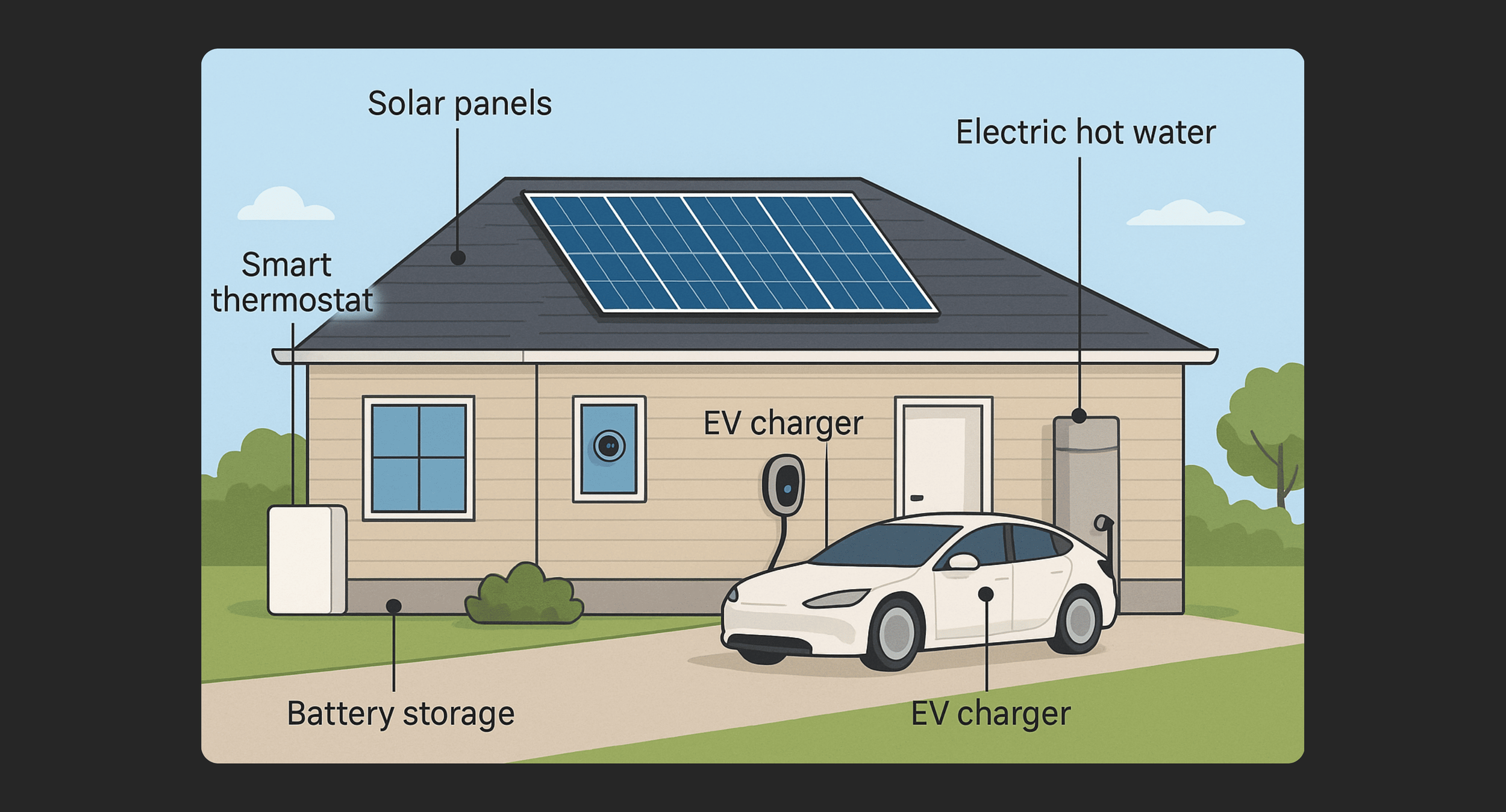What Power Supply Do You Need to Go All-Electric at Home?
Thinking of ditching gas and going fully electric? Good call. It’s where Melbourne homes are headed. But before you start swapping out your cooktop or installing that new EV charger, there’s one key thing to check: your home’s power supply.
For most small to medium homes with average energy use, a single-phase power supply is perfectly fine. But if you’re planning to run high-demand appliances or go completely electric, you may need to upgrade to three-phase power.
In this article, we’ll explain why Melburnians are making the switch, what an all-electric home looks like, and what kind of power setup you’ll need to make it work. We’ll also share what the upgrade process actually involves.
Why Aussies Are Going All-Electric
Here are the top reasons your neighbours are already calling us to help them build all-electric homes.
1. Victoria’s Gas Phase-Out Roadmap
The Victorian Government plans to cut gas use by 70% by 2025. New gas connections are off the table, and when it’s time to replace old gas appliances, they’ll need to be electric.
2. Net Zero by 2050
Australia’s aiming for net zero emissions by 2050, and swapping gas for clean electricity is one of the easiest, most effective steps you can take right at home.
3. Lower Energy Bills
The Victorian Government estimates you could save $1,000–$2,000 a year by going electric with solar and batteries. Gas prices keep climbing, but sunshine will always be free (1).
4. Healthier and Safer Homes
Gas appliances can leak or release carbon monoxide, which isn’t great for your health. Electric systems are cleaner, safer, and often filter dust, pollen, and allergens too.
5. Solar Victoria Rebates
Right now, Solar Victoria is offering rebates of up to $1,400 for solar panel installations, plus interest-free loans to match (2). Even renters can qualify. Check their website to see details.
What Does an All-Electric Home Look Like?
An all-electric home runs entirely on electricity, no gas required. Everything from heating and cooling to hot water and cooking runs off clean power.
Here’s what that might include:
Reverse cycle heating and cooling
Solar or electric hot water
Induction cooktops
EV charging stations
Smart home and energy management systems
Most of these homes generate their own power through solar panels and store excess energy in batteries. Add in smart controls, insulation upgrades, and automation, and you’re well on your way to a 7-star NatHERS rating (3).
How Much Power Do You Really Need?
If you’re partly electric now, you’re probably using around 15–25 kWh/day.
A fully electric household with induction cooking, electric hot water, heating, and an EV charger could use 40–60 kWh/day.
Here’s a quick breakdown:
Induction cooktop: ~7 kW
Hot water system: ~5 kW/day
Heating and cooling: ~8 kW/day
EV charger: 7–22 kW
So, the question is, can your current power supply handle that?
Here’s an article on how much an EV charger installation costs in Melbourne.
Single vs Three-Phase Power: Which Is Right for You?
In Australia, single-phase power delivers 230V, which suits most smaller homes. But if you’re adding multiple heavy-duty appliances like EV chargers, large reverse-cycle systems, or pool heaters, you’ll likely need three-phase power, which delivers 415V and handles higher loads more efficiently.
At AJD Electrical Solutions, we don’t push unnecessary upgrades. We’ll assess your current setup, look at your future plans, and recommend three-phase only if it’s truly needed.
Signs You Might Need a Power Supply Upgrade
Here are a few signs that your single-phase system might be struggling:
Circuit breakers tripping often
Flickering or dimming lights
Burning smells or heat near the switchboard
Your home is 20+ years old and hasn’t had an electrical upgrade
The Upgrade Process – Step by Step
Upgrading to three-phase sounds complicated, but we make it straightforward. Here’s how it works:
Assessment: We check your home’s energy use and appliances.
Planning: We outline what needs upgrading, from switchboards to rewiring.
Approvals: We liaise with your local distributor for the necessary approvals.
Installation: Once approved, we complete the work, usually in 2–3 days.
Futureproofing: We make sure your new setup is ready for future growth, such as EVs or battery storage.
Why Upgrade Now?
If your home is 20+ years old, it’s probably due for an electrical upgrade anyway. Doing it now, while you’re switching to electric, helps you avoid double-handling costs down the track.
With solar rebates likely to reduce or end by 2026 and EV sales booming, upgrading now helps you futureproof your property and boost its resale value.
Why Melbourne Locals Trust AJD Electrical Solutions
We’re a family-owned business that’s been helping Victorians modernise their homes for over a decade. Here’s why people keep coming back:
Over 10 years of hands-on experience
Fully licensed and insured team
Deep knowledge of local compliance
Transparent, obligation-free quotes
24/7 emergency support
Ready to go all-electric?
Give us a call, we’re happy to chat.





